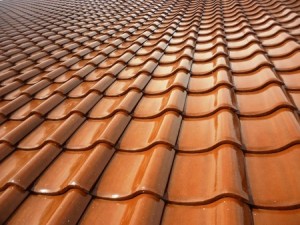LOOK AFTER YOUR ROOF
Water, food, shelter. Once you’ve secured those you’re sorted. Right? Well yes, but not in a put-your-feet-up and do nothing else kind of way. You need to ensure the supply of those three basics are continuous, and that includes maintaining that roof over your head.
Storms, heavy rain, wind, ice and snow will all impact on your roof, and the cost of the damage caused by a leak will almost certainly exceed the cost of fixing the issue quickly. So, to keep your roof in the best possible condition, be vigilant, and that means regular inspections.
 The first and most important thing to consider is safety. Unless you’re Tom Cruise, Spider-Man, or a squirrel, do not walk on your roof; the likelihood of damaging a tile could be the least of your worries up there. If you’re comfortable with heights, view your roof using a ladder, preferably with someone on the ground taking notes for you. If heights make you uneasy, find a good position to view your roof with a pair of binoculars. If neither of those options work for you, call a roofing maintenance professional.
The first and most important thing to consider is safety. Unless you’re Tom Cruise, Spider-Man, or a squirrel, do not walk on your roof; the likelihood of damaging a tile could be the least of your worries up there. If you’re comfortable with heights, view your roof using a ladder, preferably with someone on the ground taking notes for you. If heights make you uneasy, find a good position to view your roof with a pair of binoculars. If neither of those options work for you, call a roofing maintenance professional.
However, before venturing near your roof (or bringing in someone to go up there for you), first check inside your house. Look for dark or browning spots, or blistering and bubbling paint on ceilings; these are indicators of water damage. Also check for damp spots forming near fireplaces: chimneys are a common source of leaks. If that’s all fine, move on to the loft. If possible, do this on a sunny day, that means you’ll see sunlight lancing in through worn or broken shingles. If it’s rained recently, any water damage should be obvious, but also inspect for signs of previous leaks, which should include checking the eaves for signs of staining: this is a clear indicator of damp.
With the interior of your home checked, it’s time to move on to the outside of your roof. You’re checking for more than missing shingles or tiles. Dark patches or lines likely means damage. Also look out for curling and cupping or a large number of chipped and buckled shingles, and be aware of granules from shingles. Some of those will naturally come off and be in the gutters or at the bottom of downspouts, but when those have started to pile up, and your roof is visibly uneven and spotty from loss of those grains, it’s an indication that your roof is getting quite old, and you should consider shingle replacement.

After inspecting the shingles or tiles, turn your attention to your building’s chimneys. It’s important to check the flashing and make sure that it isn’t peeled away, dislodged or otherwise damaged. If you have skylights, your inspection of your home’s interior should already have highlighted any issues, but have a look from the outside anyway, especially if it hasn’t rained in a while. Vents or any structure that penetrates through the roof should be checked to ensure sealant isn’t cracking or peeling away.
Next, moss.
First, you need to know the difference between black algae spots and moss: Black algae isn’t nice to look at, but it only affects aesthetics. It doesn’t harm your roof. However, moss is a problem because it holds water; it’s very important that it’s removed. If you catch moss early, you may be able to just sweep it away, but if moss has established itself for a while it needs to be killed off. You should opt for a product that has potassium salts of fatty acids rather than a product with a toxic formula that includes zinc sulphate. Only apply the mixture where the moss is growing. Again, if this isn’t a job you’re comfortable with, contact a roofing maintenance professional. By removing moss you’ll reduce the chances of dampness becoming an issue and you’ll also be able see any damage that the moss has been hiding.
Cleaning your gutters is an important job, especially around spring and autumn. If debris piles up too high in the gutters, it prevents water from flowing through to the downspouts. If this happens, water can end up soaking into the roof and start to rot parts of it. Gutters also prevent damage to the foundation which can lead to wet basements, staining, erosion, and massive bills to fix the damage. Your roof inspection should also take into account the condition of your guttering and downpipes. Excessive wind may cause gutters and pipes to become loose or detached, so it’s worth investing some time to check these regularly.
While you are up there, why not install a Gutter Brush? This is designed to easily and efficiently keep debris out of your guttering system. A Gutter Brush is simple to install; simply remove any debris from the guttering, lay the brush into the guttering so that it lies just under the roof tiles and cut it to the length of pipe. It will stop any debris such as leaves from accumulating as well as putting off the growth of moss. It requires very little maintenance although we recommend giving it a jet wash once a year.
Finally, take a look at what’s around your roof: are there overhanging trees? Branches that lead directly to your roof not only provide easier access for squirrels, Spider-Man and Tom Cruise, they can scrape and damage your roof and send shingles flying in strong winds. There’s also the potential for branches to break off in a storm and cause significant damage, and the shade they provide allows moss to grow more efficiently, so keep branches trimmed about 10ft away from your roof. Again, your first thoughts should be about safety, and if you don’t have the proper tools and safety equipment and clothing (and some experience of the work involved) please contact a professional for help.
 ABOUT THE AUTHOR
ABOUT THE AUTHOR
Darren Searles is Manager Director of JJ Roofing Supplies. Founded in 1989, JJ Roofing Supplies Limited is now one of the largest roofing merchants with six stores, an e-commerce outlet, a staff of over 70. JJ Roofing Supplies sources high quality roofing materials to trade and residential customers.
For more information, see:
Facebook: jjroofingsupplies
Twitter: @JJ_Roofing
LinkedIn: linkedin.com/company/2955922

